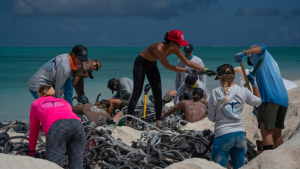
Freedivers from the Papahānaumokuākea Marine Debris Project (PMDP) finished a 28-day cleanup expedition to the Papahānaumokuākea Marine National Monument (the Northwestern Hawaiian Islands) removing a total of 126,310 lbs of marine debris. Thirteen of the 16 team members who were involved have ties to the University of Hawaiʻi.
This was PMDP’s second large-scale effort in 2023, with a previous expedition completed during the month of July.
The team encountered seven live green sea turtles that had become entangled in ghost nets, including three adults trapped in the same net. Fortunately, they were able to free all seven turtles.

“If we’re seeing this level of animal entanglement and mortality during just a couple of days here, you can imagine how many more of these situations go unseen during the rest of the year,” said PMDP President Kevin O’Brien, a 2006 UH Mānoa graduate in zoology and RCUH employee from 2007 to 2019. “We have an unseen problem on our hands. Out of sight, out of mind.”
PMDP conducts multiple annual cleanup expeditions to the remote Hawaiian islands, reefs and atolls of Papahānaumokuākea to reduce the risk of entanglement for many species of protected wildlife, to mitigate coral reef damage and minimize risk of plastic ingestion for seabirds.
Removing ghost nets, other debris
Cleanups were conducted at Lalo (French Frigate Shoals), Kamokuokamohoaliʻi (Maro Reef), Hōlanikū (Kure Atoll) and Manawai (Pearl and Hermes Atoll). Despite visiting four locations within Papahānaumokuākea, the team’s primary focus was the cleanup of Manawai, which lies nearly 1,200 miles from Honolulu. This maze of coral reefs creates a sheltered habitat for a diverse array of marine species, but also unfortunately traps a large amount of floating derelict fishing gear (ghost nets). Due to its size, at least half of Manawai’s surveyable lagoon area had not been cleaned in more than 10–15 years.
Of the 126,310 lbs total:

- 102,310 lbs were ghost nets removed from the reefs
- 18,145 lbs were ghost nets removed from the shorelines
- 1,030 lbs were shoreline plastics
- 4,825 lbs were larger derelict items (boat, buoys)
“These larger, heavier items that wash in from elsewhere in the Pacific can have a significant impact too,” said O’Brien. “They bash their way through delicate coral reefs as they drift in from the open ocean, and can continue to destroy corals long-term when storms or high tides remobilize them and keep them moving around.”
UH impact
Other PMDP team members with UH ties:
- James Morioka (Executive Director)—UH Mānoa, 2012, BS marine biology, RCUH employee 2011–22
- Kaʻehukai Grant Goin—UH Mānoa, 2021, BA Hawaiian studies; currently pursuing a MS in tropical conservation biology and environmental sciences at UH Hilo
- Nāmele Naipo-Arsiga—UH Mānoa, 2017, BS kinesiology and rehabilitation science
- Sydney Luitgaarden—UH Mānoa, 2019, BS marine biology
- Charlotte Frank—currently enrolled at UH Mānoa in the Graduate Ocean Policy Certificate program in the College of Social Sciences
- Kiana Poki—UH Mānoa, 2014, BA sociology and psychology
- Sean Guerin—RCUH employee, 2005–06, 2009–13
- Andrew Sulivan-Haskins—RCUH employee 2017–present
- Max Moonier—Hawaiʻi Institute of Marine Biology former employee, Coral Resilience Lab
- Lauren Chamberlain (Fraser)—former UH Mānoa student
- Ford Stallsmith—former Hawaiʻi Community College–Pālamanui student
- Richard Chen—UH Mānoa 2021, BS marine biology
Visit www.pmdphawaii.org to learn more about the project or to support future efforts.

